Golden Candles - Pachystachys lutea
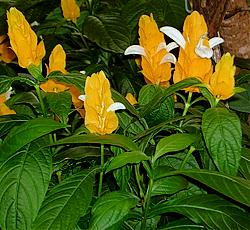 This attractive plant comes from South America and is grown for its bright yellow flower spikes, almost continuously throughout the year.
This attractive plant comes from South America and is grown for its bright yellow flower spikes, almost continuously throughout the year.
It will grow outdoors in semi-shade, in frost- free regions, where it will grow +-1m tall and +-60cm wide.
Place this plant in a warm, bright place indoors, away from direct sunlight. Water it well in hot weather and feed it regularly when it is in flower. Prune it lightly after it has flowered.
Prayer Plant - Maranta
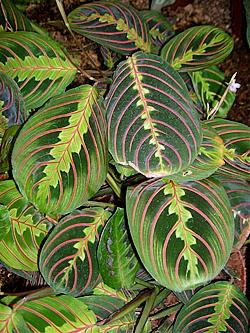 Maranta erythrophylla
Maranta erythrophylla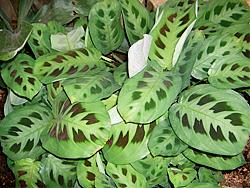 Maranta kerchoveanaMaranta's are native to the tropical regions of South America and are called prayer plants because their leaves fold up at night, giving them the appearance of folded hands. They dislike very bright light, so try them in bathrooms or other low light areas.
Maranta kerchoveanaMaranta's are native to the tropical regions of South America and are called prayer plants because their leaves fold up at night, giving them the appearance of folded hands. They dislike very bright light, so try them in bathrooms or other low light areas.
Plant them in well-drained potting soil and water regularly, never letting the soil totally dry out. Spray the leaves often with water. Feed regularly in the summer, but let your plant rest in winter, by cutting down on water, and food.
Florist Kalanchoe, Flaming Katy, Kalanchoe ‘Tessa’, Flower Dust Plant - Kalanchoes

Several species of Kalanchoe are available for the garden and home, and these gorgeous hybrids have luscious succulent leaves and sturdy stems, bearing clusters of long lasting flowers in vibrant shades.
Kalanchoe blossfeldiana (Florist Kalanchoe, Flaming Katy, Christmas Kalanchoe) is most commonly sold as a houseplant, but also thrives outdoors in mild climates. A wonderful selection of this Kalachoe is available to gardeners, and their large, scalloped, emerald green leaves, and profusion of single or double blooms in many shades of pink, yellow, orange, red, white, and cream, makes them simply irresistible!. Hybrids remain compact and bushy, growing between 30 and 45cm tall. Indoors the Flaming Katy grows best in bright filtered light.
Kalanchoe ‘Tessa’ generally grows about 30cm tall and 60cm wide, with oval, medium-green leaves, often with red edges. The flowers start appearing in late winter to spring, on pendent panicles which bear an abundance of tubular, 2cm long, nodding flowers in various shades of orange-red. This lovely garden hybrid is most attractive and hard to ignore when in full bloom, and its spreading growth habit makes it a perfect groundcover for mild regions. It is also perfect for pots, hanging baskets and window boxes. Indoors, it grows best in bright filtered light.
Kalanchoe pumila (Flower Dust Plant) is a tough little groundcover for the garden in mild winter regions because it seldom exceeds 25cm in height, but spreads 40 to 50cm wide. It is low maintenance, water-wise, and will take full sun or semi-shade. Its serrated leaves are powdery grey with a lilac tint, and lovely clusters of lilac to mauve flowers with conspicuous yellow anthers appear in winter to spring. Its lovely grey leaves are perfect in the garden to highlight other colours, and grey also shows up beautifully at night. This plant is also a great to plant in pots, window boxes or hanging baskets because it is neat and attractive all year round. It can be grown indoors if given enough bright filtered light.
 Kalanchoe blossfeldiana 'Double Pink'Kalanchoes are easy to grow indoors and thrive outdoors in subtropical and mild winter regions. They take heat and humidity, but are tender to frost. However, they can be cultivated in colder gardens, if they are protected and in a sheltered position, or are planted into pots which can be moved in winter.
Kalanchoe blossfeldiana 'Double Pink'Kalanchoes are easy to grow indoors and thrive outdoors in subtropical and mild winter regions. They take heat and humidity, but are tender to frost. However, they can be cultivated in colder gardens, if they are protected and in a sheltered position, or are planted into pots which can be moved in winter.
Although they are succulents and require very well-drained soil, Kalanchoes will thrive if the soil contains a good amount of organic matter like compost or potting soil. To promote flowering, potted specimens, as well as those growing in beds, can be fed two to three times during the growing season with a liquid or foliar fertiliser for flowers. Do not overwater Kalanchoes, water thoroughly when the soil in the pot or garden bed is totally dry, and do not leave pots sitting in a drip tray full of water, or root rot will occur. Water your plants sparingly during their rest period in winter.
Although Kalanchoes will grow in full sun in the garden they may struggle or get scorched in our hot summer sun. They thrive in bright shade, or a couple of hours of direct sun, and if grown indoors they must be placed in a warm spot with very bright light, and although some direct sunlight won’t do them any harm, direct sunlight for more than 2 hours may damage your plant. Also, keep plants away from hot window panes – touching that glass will burn the plant. And in winter it’s the opposite – cold window panes will also cause damage.
 Kalanchoe blossfeldiana 'Double White'Full Version:
Kalanchoe blossfeldiana 'Double White'Full Version:
Description, History & Interesting Facts:
All Kalanchoes are popular plants for the garden and home, but the little ones, appropriately called “Flaming Katy” have become one of the most popular flowering succulents in South Africa and the world. People love to use them for instant colour indoors because they are easy to care for and are available all year round in full bloom. And, because they are inexpensive they can be discarded once they’ve finished blooming. However, frugal gardeners transplant them into the garden or outdoor pots, knowing that if cared for correctly, they will return and flower again every winter and spring.
Kalanchoes are tropical flowering succulents in the family Crassulaceae, and there are about 125 species. The genus is predominantly native to the Old World, tropical Africa, and especially Madagascar where 60 species occur. In southern and eastern Africa there are about 56 species, only 1 species occurs in the Americas, and a few are found in south-eastern Asia and China.
 Kalanchoe blossfeldiana 'Double Red'Flaming Katy (Kalanchoe blossfeldiana) was discovered by the German seed merchant Robert Blossfeld, who brought it to Paris. After a period of selective breeding, in 1932 he marketed the plant as a houseplant, much to the delight of gardeners. Danish and Dutch breeders also saw the potential of Kalanchoes, and in the late 1980’s their breeding efforts helped the humble Kalanchoe break through internationally. The popularity of “Flaming Katy” never seems to wane; and in 1971 it was one of the first plants to be sent into space on a resupply to the Soviet Salyut 1 space station – quite a feat for such a little plant!
Kalanchoe blossfeldiana 'Double Red'Flaming Katy (Kalanchoe blossfeldiana) was discovered by the German seed merchant Robert Blossfeld, who brought it to Paris. After a period of selective breeding, in 1932 he marketed the plant as a houseplant, much to the delight of gardeners. Danish and Dutch breeders also saw the potential of Kalanchoes, and in the late 1980’s their breeding efforts helped the humble Kalanchoe break through internationally. The popularity of “Flaming Katy” never seems to wane; and in 1971 it was one of the first plants to be sent into space on a resupply to the Soviet Salyut 1 space station – quite a feat for such a little plant!
Today hybridization continues and there are several species of Kalanchoe available for the garden and home. These gorgeous hybrids have luscious succulent leaves and sturdy stems, bearing clusters of long lasting flowers in vibrant shades of pink, yellow, orange and red, as well as lighter shades which include white and cream. Because of their popularity, they are available everywhere - garden centres, grocery stores, and florists. Flowering Kalanchoes bloom for at least eight weeks, and it is this endurance that gives the plant its symbolic meaning of persistence and eternal love, making these little gems cheerful and inexpensive gifts. They are adorable potted together in clumps, or mixed with other water-wise plants and succulents.
Kalanchoe blossfeldiana (Florist Kalanchoe, Flaming Katy, Christmas Kalanchoe) is most commonly sold as a houseplant, but also thrives outdoors in mild climates. It is native to the island of Madagascar, where it grows in the relatively cool plateaus of the Tsarantanana Mountains, in humus soil, forming small upright shrubs with thick, waxy green foliage with a succulent appearance. Today a wonderful selection of this Kalachoe is available to gardeners, and their large, scalloped, emerald green leaves, and profusion of single or double blooms in many shades of pink, yellow, orange, red, white, and cream, makes them simply irresistible! Hybrids remain compact and bushy, growing between 30 and 45cm tall. Indoors the Flaming Katy grows best in bright filtered light.
 Kalanchoe pumila Image by Jason from PixabayKalanchoe ‘Tessa’ generally grows about 30cm tall and 60cm wide, but with maturity can get a lot larger. This evergreen perennial has oval, medium-green leaves, often with red edges, and the flowers start appearing in late winter to spring, on pendent panicles which bear an abundance of tubular, 2cm long, nodding flowers in various shades of orange-red. This lovely garden hybrid is most attractive and hard to ignore when in full bloom, and its spreading growth habit makes it a perfect groundcover for mild regions. It is also perfect for pots, hanging baskets and window boxes. Indoors, it grows best in bright filtered light.
Kalanchoe pumila Image by Jason from PixabayKalanchoe ‘Tessa’ generally grows about 30cm tall and 60cm wide, but with maturity can get a lot larger. This evergreen perennial has oval, medium-green leaves, often with red edges, and the flowers start appearing in late winter to spring, on pendent panicles which bear an abundance of tubular, 2cm long, nodding flowers in various shades of orange-red. This lovely garden hybrid is most attractive and hard to ignore when in full bloom, and its spreading growth habit makes it a perfect groundcover for mild regions. It is also perfect for pots, hanging baskets and window boxes. Indoors, it grows best in bright filtered light.
Kalanchoe pumila (Flower Dust Plant) is a tough little groundcover for the garden in mild winter regions because it seldom exceeds 25cm in height, but spreads 40 to 50cm wide. It is low maintenance, water-wise, and will take full sun or semi-shade. Its serrated leaves are powdery grey with a lilac tint, and lovely clusters of lilac to mauve flowers with conspicuous yellow anthers appear in winter to spring. Its lovely grey leaves are perfect in the garden to highlight other colours, and grey also shows up beautifully at night. This plant is also a great to plant in pots, window boxes or hanging baskets because it is neat and attractive all year round. It can be grown indoors if given enough bright filtered light.
 Kalanchoe blossfeldiana Image by Karolina Grabowska from PixabayUses:
Kalanchoe blossfeldiana Image by Karolina Grabowska from PixabayUses:
In traditional medicine, Kalanchoe species have been used to treat ailments such as infections, rheumatism and inflammation. Extracts are known to have immunosuppressive effects; and Kalanchoe pinnata has been recorded in Trinidad and Tobago as being used as a traditional treatment for hypertension.
In the home & garden:
All flowering Kalanchoes thrive outdoors in the subtropical, frost-free regions of South Africa, where they are invaluable in rock or succulent gardens for their blooming potential, easy care, low water requirements, as well as their ease of propagation, enabling gardeners to fill large areas at little cost.
In warm regions they can be planted outdoors at any time, and in colder regions they are often planted outdoors for special occasions, looking wonderful in mixed containers, window boxes and hanging baskets.
Because Flaming Katy Kalanchoes are available all year round in full bloom, and come in a good array of colours, they fit effortlessly into various styles of interior design, from classic to modern.
Cultivation/Propagation:
Kalanchoes are easy to grow indoors and thrive outdoors in subtropical and mild winter regions. They take heat and humidity, but are tender to frost. However, they can be cultivated in colder gardens, if they are protected and in a sheltered position, or are planted into pots which can be moved in winter.

Although Kalanchoes will grow in full sun in the garden they may struggle or get scorched in our hot summer sun. They thrive in bright shade, or a couple of hours of direct sun, and if grown indoors they must be placed in a warm spot with very bright light, and although some direct sunlight won’t do them any harm, direct sunlight for more than 2 hours may damage your plant. Also, keep plants away from hot window panes – touching that glass will burn the plant - ouch! And in winter it’s the opposite – cold window panes will also cause damage.
Just like Poinsettias, Flaming Katy is generally not easy to get to repeat-flower indoors, because in nature they only flower in winter, and are forced to bloom all year round by the flower industry. They are photoperiodic, meaning they react to periods of light exposure and need at least 12 to 14 hours of complete darkness to bloom again. And, chances are if you have them in your home, you have them in a room that isn’t getting that amount of complete darkness. However, if you want to give it a try, starting in winter, cut back on watering and put them in a closet or a room that’s pitch black for 12 to 14 hours a day, and do this for at least 2 months. The best temperatures for formation of flowers are between 4 to 7° C at night and 16° C during the day.
Propagation of Kalanchoes is easy by stem cuttings taken in spring or summer. Cut stems about 10cm long and remove the bottom leaves. Allow the stems to lie for a day or so, or until the cut is dry. Plant in well-drained soil, or a specialist succulent & cactus mix. Rooting hormones can be applied to speed up rooting. Keep the soil moist but not soggy, mist the foliage regularly while they're rooting, and within about 3 weeks the cuttings will be ready to transplant into individual pots to grow on.
 Kalanchoe 'Single Orange'Problems, Pests & Diseases:
Kalanchoe 'Single Orange'Problems, Pests & Diseases:
Kalanchoes are not susceptible to many pests and diseases but watch out for aphids and mealybugs. For most soft-bodies insects, an organic insecticidal soap like Neem can be used. If overwatered, stem rot can occur.
Warning:
All parts of Kalanchoe are poisonous, the roots, leaves, and especially the flowers, so keep them well away from children and pets.
Spider Plant - Chlorophytum comosum
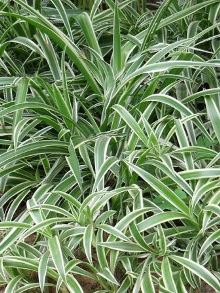 The Spider Plant is a popular houseplant with both green and variegated varieties. It is especially popular plant with beginners as it is easy to grow and is very tolerant of neglect; being able to thrive in a wide range of conditions.
The Spider Plant is a popular houseplant with both green and variegated varieties. It is especially popular plant with beginners as it is easy to grow and is very tolerant of neglect; being able to thrive in a wide range of conditions.
They need bright natural light indoors and can get sunburnt if grown in too much direct sunlight. They also do very well when grown under grow lights, but will be reluctant to produce the plantlets unless you decrease their light hours to simulate the naturally shorter days of autumn, when they normally produce their 'babies'.
Keep the soil evenly moist, but never soggy. Feed the plant every 3 or 4 months with any pot plant fertilizer. Over fertilizing will damage the plant, so when you feed use 1/2 of the recommended strength.
On mature plants the tips of the leaves can go brown and this is generally caused by chemicals in the water. If you are using city water for your plants that has been chlorinated it can cause the burn. Using rainwater or distilled water will take care of this problem.
Researchers at the USbased National Space Technology Laboratories found that a single spider plant enclosed in a room filled with formaldehyde (found in air fresheners and detergents) removed 80% of pollutants in only one day. If you have a gas geyser in the bathroom, the spider plant will help clear the carbon monoxide from the air as well.
Bamboo Palm, Golden Bamboo Palm, Golden Cane Palm, Areca Palm, Butterfly Palm - Dypsis lutescens (formerly Chrysalidocarpus lutescens)
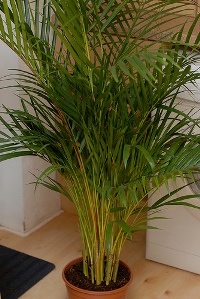 Picture courtesy Darren Hobbs
Picture courtesy Darren Hobbs
Condensed Version:
The bamboo palm remains popular for indoor culture and if it is grown in a large pot can attain great heights indoors, but if space is limited, cute little specimens are available at retail outlets, which if cared for correctly can live for a long time, rather like a little bonsai.
Outdoors it is perfect for frost free regions, and a moderately salt tolerant palm for coastal gardens, but does better well where it is sheltered from strong winds. In the garden it is good to plant reasonably close to swimming pools, because the surface roots are usually not a problem. However, falling fruits can be messy. If planted closely together the plants will make an excellent screen.
Indoors, it will grow beautifully when surrounding temperatures hold around 18 to 22°C, and if it is placed in moderate to bright light. Even some direct sunlight won’t harm it, but be careful as too much direct sunlight may burn the fronds. These palms also dislike fluoridated water, so try to water with rain water or purified water whenever possible.
Watering correctly is very important and in summer, potted specimens must be watered regularly, allow the potting soil to almost dry out before watering thoroughly again, but never allow the soil to dry out totally. In the hotter, frost-free regions of the country it is necessary to water well throughout the year, but in cold regions your palm tree will not be growing much, if at all in winter, so water moderately, and less often.
Feed your palm with a liquid fertiliser for leafy plants about every two to three weeks, taking great care to moisten the soil beforehand. Do not feed in winter.
Generally potted bamboo palms will only need repotting in spring every 2 or 3 years, but if re-potting isn't an option, give your plant a top-dressing of potting soil, and feed regularly.
In the drier regions of the country it is necessary to increase humidity around the fronds, to try to mimic the bamboo palms natural humid growing conditions. A room humidifier would work miracles, especially during cold and dry winters when many homes are heated and humidity is even lower. Mist spraying the leaves down regularly with tepid water is a great way to increase humidity, and will help prevent the tips of the leaves from going brown. An occasional spell outside in the warm summer rain would also go down a treat. Avoid using leaf shine on palms.
Outdoors bamboo palms thrive in the frost-free regions of South Africa. Generally speaking, they do not tolerate cold well and can only take short spells of light frost. They are moderately salt tolerant and do well in sheltered coastal gardens. Outdoors they grow quickly, and can be planted in full sun or semi-shade - in the sun the leaves have a yellowish colour, but in semi-shade they are lush green. Like potted specimens, they require well-drained soil, and regular watering and feeding in summer.
Full Version:
Description, History & Interesting Facts:
This graceful multi-stemmed palm has a soft, leafy appearance which will enhance indoor spaces, and is a lovely addition to tropical and subtropical gardens. It is known to be one of the top air-purifying plants for indoors, and a natural humidifier, improving the air quality of your home or office, as well as adding a relaxing tropical feel.
In the garden it can be sited in semi-shade or full sun - in the sun its leaves take on a lovely yellowish colour, but in semi-shade they are a lush forest green, making the bamboo palm very versatile in the garden, adding great contrast in colouring as well as form. Another common name for this palm is “Golden Cane Palm” in reference to its yellow stems.
The bamboo palm is native to the Comoro archipelago situated in the Indian ocean northeast of Madagascar and consisting of four main islands, as well as Pemba Island and Madagascar, although in Madagascar is has sadly become rare and endangered.
In subtropical and tropical regions, the bamboo palm can grow to a height of 6 to 9m or more, with a spread of 3 to 4m, with its clusters of stems becoming very dense. Small, inconspicuous white flowers are produced all year round on long stalks among the leaves, and these are followed by small, oblong, black fruits which ripen all year round.
In the Garden & Home:
The bamboo palm remains popular for indoor culture because it blends effortlessly with all styles and colour schemes, from classical to modern, adding a sense of elegance to any room. If it is grown in a large pot, it can attain great heights indoors, but if space is limited, cute little specimens are available at retail outlets, which if cared for correctly can live for a long time, rather like a little bonsai.
If it is happy in its location, the bamboo palm is fast growing, and because it transpires one litre of water every 24 hours, is fantastic for cleaning indoor air. This exceptionally high transpiration rate makes this plant among the best for removing benzene (found in varnish) and chemicals found in plastic toys. It also effectively removes xylene and toluene (both found in paint.) Even a baby specimen can make a big difference to air quality in a room.
Outdoors it is perfect for frost free regions, and a moderately salt tolerant palm for coastal gardens, but does better well where it is sheltered from strong winds. In the garden it is good to plant reasonably close to swimming pools, because the surface roots are usually not a problem. However, falling fruits can be messy. If planted closely together the plants will make an excellent screen.
Cultivation/Propagation:
 Image created by FreepikIndoors:
Image created by FreepikIndoors:
If you are growing a bamboo palm indoors, it will grow beautifully when surrounding temperatures hold around 18 to 22°C, and if it is placed in moderate to bright light. Even some direct sunlight won’t harm it, but be careful as too much direct sunlight indoors, especially if the plant is close to a window without lace curtains or blinds, may burn the fronds.
Because the bamboo palm won’t cope well with cold and lack of light indoors, if you live in a house that is quite dark, and perhaps also cold in winter, avoid purchasing a bamboo palm unless you can provide grow lights, which will help growth and also increase the temperature slightly.
These palms also dislike fluoridated water, so try to water with rain water or purified water whenever possible.
Watering correctly is very important for bamboo palms, and commercially grown potted specimens are cultivated in extremely well-drained potting mixtures, which may contain quite a lot of bark etc. because growers know that most indoor plants are killed with kindness i.e. normally they are drowned with too much water. In summer, potted specimens must be watered regularly, allow the potting soil to almost dry out before watering thoroughly again, but never allow the soil to dry out totally. This is where a moisture meter would come in very handy. In the hotter, frost-free regions of the country it is necessary to water well throughout the year, but in cold regions your palm tree will not be growing much, if at all in winter, so water moderately, and less often. Palms do well in self watering pots, which will keep the soil lightly moist and reduces the need for you to monitor your palm constantly.
Generally potted bamboo palms will only need repotting in spring every 2 or 3 years, but if re-potting isn't an option, give your plant a top-dressing of potting soil, and in summer, feed with a liquid fertiliser for leafy plants about every two to three weeks, taking great care to moisten the soil beforehand. Do not feed in winter.
If you wish to re-pot your bamboo palm into a larger container, it is vital that the potting soil has perfect drainage. However, if you find that the soil drains a bit too well and you are continually having to water your plant, the potting soil can be amended to add to its water retention capabilities by adding about one third of compost to the potting mix, and water retaining materials like vermiculite can also be added.
Because most potted plants like being in pots which are more ‘snug’ around their roots, select a pot which is only one to two sizes larger than the one your palm is currently growing in. Remember to check that the pot has drainage holes, and add a good layer of small stones to cover the holes before adding the soil. This will ensure that the roots don’t wallow in water, which could be fatal to your plant.
When repotting be sure that you’re planting it at the same depth it was in the previous pot. If you plant too deeply it can cause serious injury to the plant. The roots can also be very brittle, so make sure that you’re very gentle and don’t even try to separate or spread them out.
Gently pack the soil firmly yet gently around the roots with your fingers and make sure that you don’t break the fragile roots. After you’ve pressed the soil in, water deeply and gently press the soil down again to remove any remaining air pockets, and adding more soil if required.
In the drier regions of the country it is necessary to increase humidity around the fronds, to try to mimic the bamboo palms natural humid growing conditions. A room humidifier would work miracles, especially during cold and dry winters when many homes are heated and humidity is even lower. Keep the leaves away from cold windows, air conditioners, and heat sources.
Mist spraying the leaves down regularly with tepid water is a great way to increase humidity, and will help prevent the tips of the leaves from going brown. It also helps to keep your palm tree clean and healthy. An occasional spell outside in the warm summer rain would also go down a treat. Avoid using leaf shine on palms.
Another useful tip to increasing humidity is to purchase a drip tray larger than the one recommended for the pot you have selected. Fill the tray with fine gravel or small pebbles, or stand the pot on 'pot feet'. Fill the tray with water, ensuring that the pot is standing above the water level on the stones or pot feet. This ensures that roots of your plant won't rot, and as the water slowly evaporates, it will increase humidity.
Outdoors:
Bamboo palms thrive outdoors in the frost-free regions of South Africa. Generally speaking, they do not tolerate cold well and can only take short spells of light frost. They are moderately salt tolerant and do well in sheltered coastal gardens. Outdoors they grow quickly, and can be planted in full sun or semi-shade - in the sun the leaves have a yellowish colour, but in semi-shade they are lush green. As for potted specimens, they require well-drained soil, and regular watering and feeding in summer. Feed monthly during summer with a fertiliser for leafy plants, but do not feed in winter.
Propagation:
These palm are usually planted from seed, and usually many seeds are sown into a single pot. You can germinate them at home by planting them at a uniform depth in seedling soil. Mature orange-coloured seeds have a better germination rate than newer, greener seeds. Germination takes about six weeks under the best conditions, with soil temperatures around 27°C and with relatively high humidity.
Plants can also be propagated by the careful division of smaller plants.
Problems, Pests & Diseases:
Palms, especially those grown indoors can be affected by some pests and diseases. Pests like spider mites, aphids, mealy bugs, scale, and whitefly can be treated by spraying with eco-friendly pesticides.
Yellow to brown leaves indicate that the soil may be too dry. Palms are heavy feeders, and can also develop yellowing leaves in the absence of magnesium, iron, and trace elements. Bamboo palms are also susceptible to fertiliser salts and dislike fluoridated water, which may burn the leaf tips, turning them brown.
Sudden cold spells can bring on dark spots in the leaves.
If the odd leaf turns yellow and dies, this is part of its natural growth cycle, so simply cut them off. However, if no new shoots appear, and your palm tree looks pitiful, check on your watering and drainage, and fertilise every fortnight.
If your palms leaves become twisted, this is undoubtedly due to lack of light or excess water. Position it in more light and ensure you are watering correctly.
Toxicity:
The bamboo palm is listed as non-toxic to humans, dogs, cats, and horses.
Boston Fern - Nephrolepis exaltata
 Boston Fern Picture courtesy Jim KlockeThe Boston fern is native to tropical regions throughout the world. It must be the most popular indoor fern, with its long hanging fronds of plain or frilly leaves. Many people use Boston ferns outdoors to adorn their decks and porches during the warm summer month. They grow beautifully in humid locations that receive plenty of indirect sunlight, but in cold, frosty regions they must be brought indoors in autumn if they are to survive. Boston ferns are a wonderful addition to the home; adding an elegant charm and classic beauty unlike any other houseplant.
Boston Fern Picture courtesy Jim KlockeThe Boston fern is native to tropical regions throughout the world. It must be the most popular indoor fern, with its long hanging fronds of plain or frilly leaves. Many people use Boston ferns outdoors to adorn their decks and porches during the warm summer month. They grow beautifully in humid locations that receive plenty of indirect sunlight, but in cold, frosty regions they must be brought indoors in autumn if they are to survive. Boston ferns are a wonderful addition to the home; adding an elegant charm and classic beauty unlike any other houseplant.
Boston ferns like a warm (not hot) position indoors with good light but no direct sunshine. Keep them away from cold draughts. They will flourish indoors if their specific requirements are met, but when those requirements aren't met, they slowly dry up and gradually shed their leaves.
Humidity is essential to Boston ferns, so they must receive an adequate amount of water to flourish. An average home does not provide the amount of humidity required, especially in cold winter regions when the home is heated. Fifty percent humidity is ideal. To provide your fern with some of the humidity it requires, mist spray the leaves daily with tepid (not cold) water (rainwater or filtered water is best). Placing a standing fern on a drip tray filled with pebbles and a little water also helps to create humidity. As the water evaporates, humidity is naturally provided to the plant. For excellent results, purchase a humidifier for the room. This is a great investment since it provides countless benefits to the home and family as well as to moisture loving plants.
In summer, keep the soil evenly moist but not saturated; never allowing the soil to dry out totally. In winter, allow the surface of the soil to become a little dry before watering. When the new fronds appear at the end of winter; start watering more often. During spring, summer, and autumn feed your fern every two weeks with a water soluble, high nitrogen houseplant food like Nitrosol, that is diluted to half of the recommended strength. Do not feed during the winter months.
It is not necessary to re-pot a Boston Fern until the roots entirely fill the pot. Do this by dividing the plant into a few large clumps by cutting through the roots with a sharp knife. Do not divide them into very small pieces or the plants will take too long to recover and grow. To make a potting mixture suitable for Boston ferns, combine 2 parts peat moss, 2 parts sterile potting soil, 1 part perlite and a handful of charcoal granules.
Weeping Fig, Benjamin's Fig - Ficus benjamini
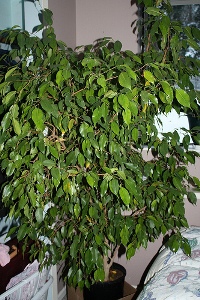 Ficus benjaminii
Ficus benjaminiiThe Weeping Fig is a species of fig tree that is native to south and southeast Asia and Australia. In its natural habitat it can reach 30 metres tall and is grown for its gracefully, drooping branchlets of glossy dark green leaves. It is a very popular pot plant, due to its elegant growth.There are numerous cultivars with different leaf variegations, ranging from dark to light green, golden yellow and white.
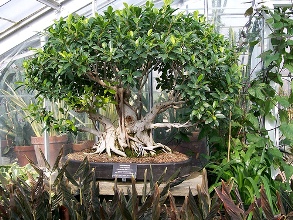 Ficus benjaminii BonsaiBenjamin's Fig grows best in warm rooms with bright light but will tolerate darker areas. It requires a moderate amount of watering in summer, and only enough to keep it from drying out in the winter. Never overwater this plant or it will suddenly drop its leaves. The leaves are also very sensitive to small changes in light and often if it is relocated to another position indoors, it reacts by dropping many of its leaves, replacing them with new leaves adapted to the new light intensity. The plant is sensitive to cold and should be protected from drafts, especially in winter.
Ficus benjaminii BonsaiBenjamin's Fig grows best in warm rooms with bright light but will tolerate darker areas. It requires a moderate amount of watering in summer, and only enough to keep it from drying out in the winter. Never overwater this plant or it will suddenly drop its leaves. The leaves are also very sensitive to small changes in light and often if it is relocated to another position indoors, it reacts by dropping many of its leaves, replacing them with new leaves adapted to the new light intensity. The plant is sensitive to cold and should be protected from drafts, especially in winter.
The Weeping Fig has been shown by NASA to effectively filter air toxins indoors and helps remove formaldehyde. It removes most pollutants, but particularly formaldehyde, the most common indoor toxin that is found in most cleaning products. It also works well to remove chloroform (found in dyes and pesticides).
The Weeping Fig makes a great bonsai specimen and is one of the very few varieties that can be grown indoors.


